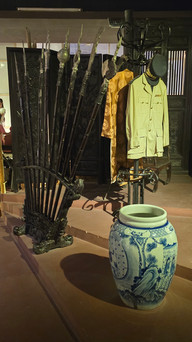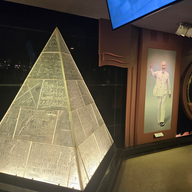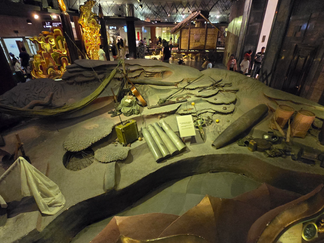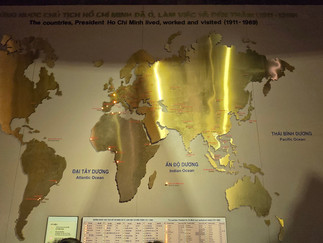Ho Chi Minh Museum
- Shannon
- Sep 1
- 4 min read
Updated: Sep 16
A Monument to Rebellion, Exile and the Heavy Cost of Independence
The Ho Chi Minh Museum in Hanoi is more than a cultural institution, it is a shrine to revolution, memory and sacrifice. Opened on May 19th 1990, the centenary of Ho Chi Minh’s birth, it stands as one of Vietnam’s most significant monuments within the larger Ho Chi Minh Complex, which includes his Mausoleum, the Presidential Palace and his Stilt House. Yet unlike those sites, the museum feels heavier, almost funereal. It is not only a tribute to the man known as “Uncle Ho” but a vast repository of the struggle that defined modern Vietnam, a place where biography and national trauma intertwine.

The building itself looms with symbolic intent. Designed in the shape of a white lotus, a sacred flower in Vietnamese tradition, it rises not as something delicate but as a stark, stone bound emblem. Its modernist lines cut sharply against Hanoi’s skyline, conveying reverence but also severity. Spanning more than 18,000 square metres across multiple levels, the structure carries the weight of permanence, as if built to withstand both time and memory. To approach it is to sense that this is no ordinary museum but a monument where the past is preserved with an almost ritual intensity.
Inside, visitors are drawn into an immense archive of over 120,000 artefacts, documents and photographs, each illuminating a fragment of Ho Chi Minh’s life. The earliest galleries recount his childhood in Nghe An Province and his decision to leave Vietnam in 1911 to search for a path to liberation abroad. These personal relics, letters, travel documents and photographs, appear humble, yet they feel charged with the burden of foresight, as though each object carries the knowledge of the conflict to come. Rather than presenting a simple timeline, the museum arranges its story through themes, art installations and symbolic displays, creating a narrative that feels less like history and more like an unfolding struggle.

Some of the most striking sections abandon traditional curation altogether. Abstract sculptures, surrealist installations and shadowed halls evoke war, colonial exploitation and revolution in a way that is deliberately unsettling. Exhibits display battered weapons, propaganda posters and battlefield relics alongside photographs of ruined villages and weary soldiers. These galleries immerse visitors in Vietnam’s defining conflicts, the wars against French colonial forces and later American intervention. The effect is haunting. Independence is not celebrated as inevitable but remembered as something torn violently from history’s grip, at great human cost.

Amid this atmosphere of upheaval, the museum preserves the paradox of Ho Chi Minh himself. His personal desk, plain clothes and modest living items are displayed almost as relics, reinforcing his reputation for austerity. Yet here, simplicity is not softened into sentimentality, it is presented as an extension of his ideology, a deliberate rejection of excess in favour of absolute purpose. The man is portrayed as inseparable from the revolution itself, a leader who renounced personal comfort yet demanded unimaginable sacrifices from his people, embodying both humility and severity in equal measure.

The final galleries widen the scope, placing Vietnam’s revolution within a global landscape of struggle. Displays link Ho Chi Minh’s vision to worldwide anti colonial movements and the tides of socialism during the Cold War. In doing so, the museum reminds visitors that Vietnam’s history cannot be isolated, it belongs to the great upheavals of the twentieth century, when empires crumbled and nations fought to define themselves. Today, the Ho Chi Minh Museum is both archive and altar, a place of patriotic pilgrimage for Vietnamese citizens and a sobering encounter for outsiders. To step into its halls is to walk through a mausoleum of memory, where the echoes of war, revolution and sacrifice still linger in the silence.
🗺️ Location
19 Ngoc Hà, Ba Đình, Hà Noi, Vietnam
🚆 How to get there
From Hanoi’s Old Quarter, the Ho Chi Minh Museum is about 3 km's to the west in the Ba Đình District. The most direct route is to follow Hàng Bài Street, continue onto Tràng Tiền, and then take Đien Biên Phu Street straight to the museum. Depending on traffic, the journey by taxi or motorbike typically takes 15 – 20 minutes. The museum is part of the larger Ho Chi Minh Complex, near the Mausoleum and the Presidential Palace, making it easy to combine visits to multiple historical sites in one trip. A ride from Hanoi’s Old Quarter to the Ho Chi Minh Museum typically costs around 50,000 - 100,000 VND by taxi, depending on traffic or about 15,000 - 20,000 VND by motorbike using services like Grab or Gojek. Walking is also an option, taking around 30 - 40 minutes for those who want to experience the city streets along the way. Prices can vary with time of day and demand, so it’s best to check your ride hailing app before confirming your journey.
⭐ Attraction Info
The Ho Chi Minh Museum welcomes visitors Tuesday through Thursday and again on Saturday and Sunday, between 8am - 12pm and 2pm - 4:30pm, while remaining closed on Mondays and Fridays. Tickets can be purchased directly at Gate 1, with morning sales running from 8am to 11:30am and afternoon sales between 2pm - 4pm, on all open days, making it easy to plan a visit around Hanoi’s busy schedule.

Thanks for reading about the Ho Chi Minh Museum. Check more awesome destinations here!




















































